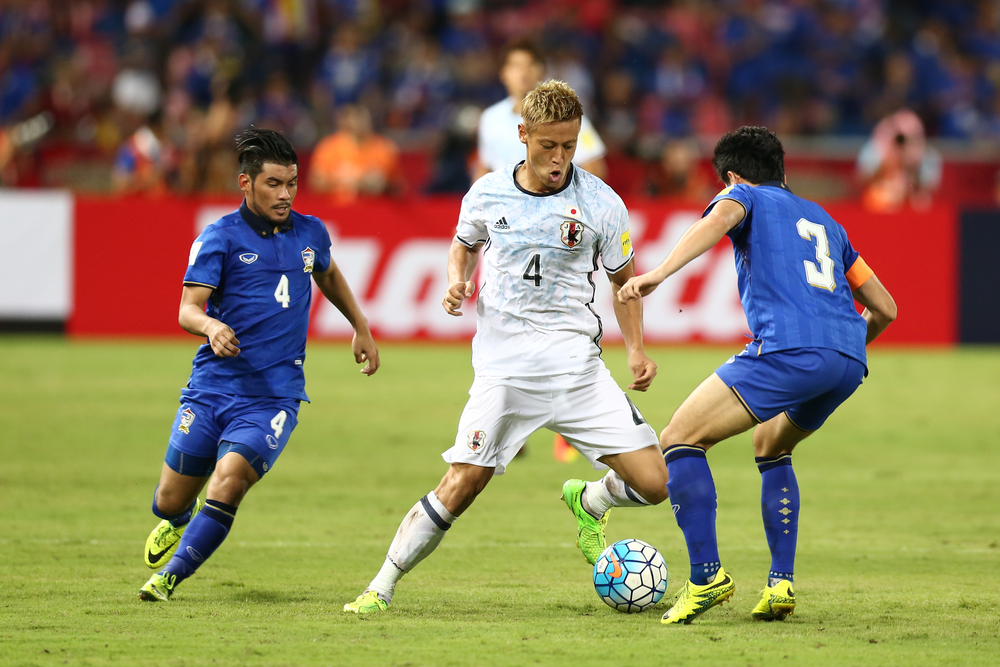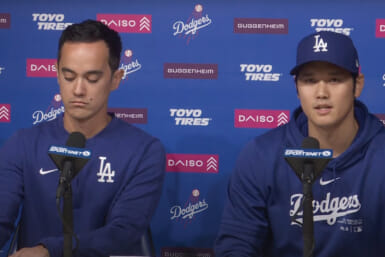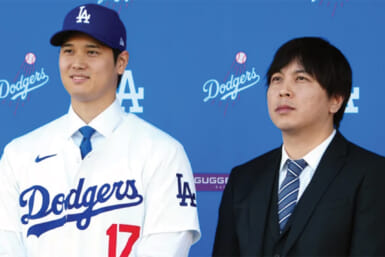With Hajime Moriyasu’s side set to kick off their World Cup campaign against Germany on Wednesday, we thought we’d look at some of Japan’s best ever footballers for our latest list of seven. Though not known as a powerhouse in the game, the country have produced some very talented players down the years.
The likes of Yasuhiko Okudera, the first Japanese man to play professionally in Europe; Shinji Ono, a UEFA Cup winner with Feyenoord; Yasuhito Endo, the nation’s most capped player and Shinji Okazaki, a Premier League winner with Leicester City, are all unlucky to miss out. As are defensive stalwarts Tsuneyasu Miyamoto, Marcus Túlio Tanaka and Yuji Nakazawa.
There are no members from the current squad out in Qatar, though names such as Wataru Endo, Daichi Kamada, Takefusa Kubo and Kaoru Mitoma will surely be making a claim to be included by the end of their careers. Four of the names featured are still playing, however, we begin by going back to the 1960s with the only player on the list who didn’t move to a team in Europe.
1. Kunishige Kamamoto
The all-time leading goal scorer for Japan, Kunishige Kamamoto was a one-club man. After graduating from Waseda University, he joined Yanmar Diesel (Cerezo Osaka) in the Japan Soccer League (JSL) in 1967. The Kyoto City-native went on to win four league titles with the team, including one as player-manager. Kamamoto hit an impressive 202 goals in just 251 appearances and was named Japanese Footballer of the Year seven times. In 1982, he ruptured his Achilles tendon twice before retiring two years later at the age of 40.
For Japan, Kumamoto won 84 caps, scoring 80 goals. That’s 25 more than Kazuyoshi Miura in second place. His biggest achievement came at the 1968 Summer Olympics in Mexico City where he helped Japan claim a bronze medal. The Yanmar Diesel forward found the net seven times to finish as the tournament’s top scorer. After retiring, he managed Gamba Osaka in the early years of the J-League. In 1995, Kamamoto was selected as a member of the House of Councillors, serving until 2001. He also served as the vice-president of the Japan Football Association for a decade, beginning in 1998.
2. Kazuyoshi Miura
On May 15, 1993, the man known as “King Kazu” lined up in the first-ever J-League game. Almost three decades on and the 55-year-old is still playing professionally and scoring, having bagged two goals this season for Suzuka Point Getters in Japan’s fourth tier. The oldest pro in the game began his career in Brazil in the 1980s. He quit school at 15 and moved to the South American country to try and make it as a footballer. In his late teens, he signed his first professional contract for Santos, the former club of Pele.
After playing for several Brazilian sides, Miura returned to Japan in 1990, helping Verdy Kawasaki (previously Yomiuri SC) win four consecutive championships, including the first two J-League titles. Along with huge names from abroad such as Zico, Gary Lineker and Dragan Stojković he was one of the stars of the division, picking up the MVP award in 1993. Two years later, he joined Genoa, becoming Serie A’s first Japanese player. His only goal for the club came in the derby game against Sampdoria. Miura, who also played in Australia and Croatia, scored 55 times for his country, but never played at a World Cup.
3. Hidetoshi Nakata
With Miura the surprise omission from the 1998 World Cup squad, Japan needed a new superstar. The man to step forward was Shonan Bellmare’s Hidetoshi Nakata. The two-time Asian Player of the Year award-winner stood out at the tournament despite the Samurai Blue’s three defeats. Perugia subsequently came calling. In his first season in what was then the world’s toughest league, Serie A’s second Japanese player impressed with 10 goals from midfield. A man in demand, he then joined Roma in 2000. Competing against fan-favorite Francesco Totti for a place in the side, though, meant first-team opportunities were limited.
Nakata’s most memorable moment at Roma came against Juventus. Brought off the bench with his team 2-0 down, he got one back with a sublime strike from 30 yards. His stinging drive at the death was then parried by Edwin Van Der Sar into the feet of Vincenzo Montella who made it 2-2. It was a huge result as Roma held off Juventus to win the Scudetto by two points. The following year, he moved to Parma, helping them lift the Coppa Italia with a goal in the final. Nakata, who also played for Fiorentina, Bologna and Bolton Wanderers, retired in 2006 after appearing at his third World Cup.
4. Shunsuke Nakamura
A player so good, “he could open a can of beans with his left foot.” These were the words of former Spurs legend Steve Perryman when he was asked about Shunsuke Nakamura. The 44-year-old ex-Celtic man finally hung up his boots last month, putting an end to an illustrious 26-year career. It began with Yokohama F. Marinos in 1997 where he was immediately seen as one of the brightest young talents in the country. The J-League’s MVP in 2000, he was surprisingly left out of the Japan squad for the 2002 World Cup.
Nakamura then moved to Reggina in Italy. His seven goals in his first season proved crucial in helping the side avoid relegation from Serie A. The creative midfielder, though, is most remembered for his time at Celtic in Scotland. Highlights included a sublime chip against Dundee United; an injury time free-kick to win the title against Kilmarnock and a 30-yard thunderbolt in the Old Firm game. Then there were his two free kicks against Man United, with the latter securing a famous 1-0 victory over the Red Devils at Celtic Park. Nakamura, who also played for Espanyol before returning to Japan, won 98 caps for his country and lifted the Asian Cup twice.
5. Makoto Hasebe
A former central midfielder turned libero (playing behind the backline), Makoto Hasebe is called the “Kaiser” by locals in Frankfurt, the nickname given to West Germany’s greatest-ever libero, Franz Beckenbauer. The Shizuoka Prefecture-native, though, is keen to play down any comparisons with Beckenbauer and another legendary German World Cup winner. “I know Lothar Matthäus and Beckenbauer operated in a similar position, but I play differently from them. They dribbled and scored lots of goals. These are things I can’t do,” Hasebe said laughing. He’s not wrong. In 15 years in the Bundesliga, the Japanese man has managed just seven goals.
The league’s all-time leading Asian appearance maker, he first moved to Germany from the Urawa Red Diamonds in 2007. Signing for VfL Wolfsburg, he became the second Japanese player (after Okudera) to win a Bundesliga title two years later. After five years at the club, which included one appearance in goal, he moved to FC Nürnberg where he stayed for just one season. He joined Eintracht Frankfurt in 2014 and has since helped the club win the DFB-Pokal in 2018 and earlier this year, the Europa League alongside Japanese teammate Daichi Kamada. In international football, Hasebe has captained Japan at three World Cups.
6. Keisuke Honda
Prior to 2018, only five players had scored and assisted at three World Cups: David Beckham, Rudi Voller, Arjen Robben, Asamoah Gyan and Grzegorz Lato. At the tournament in Russia, Keisuke Honda became the sixth to join that exclusive list. He netted on his tournament debut against Cameroon in 2010 to give Japan their first ever World Cup victory on foreign soil. It was his goal against Denmark, though, for which he’s most remembered: a delightful dipping free kick from 45 yards out. He then provided a beautiful assist for Okazaki to make it 3-1 later in the game. It meant Japan had qualified for the knockout stages for the first time on foreign soil.
Things began well in Brazil four years later with Honda scoring after 16 minutes against Ivory Coast. That was about as good as it got for Japan, though, who finished the group with just one point. In Russia in 2018, Honda scored the crucial equalizer against Senegal as the Samurai Blue made it to the second round. In club football, Honda began at Nagoya Grampus. Since leaving them in 2007, he’s played in eight countries for 10 different clubs, including most famously AC Milan. His current team is FK Sūduva in Lithuania. He’s also the general manager and coach of Cambodia.
7. Shinji Kagawa
“We’ll win and I’ll score two goals,” Shinji Kagawa confidently predicted prior to his first Revierderby. True to his word, he bagged a brace in Borussia Dortmund’s (BVB) 3-1 defeat of Schalke, becoming an instant fan favorite. The Kobe City-native, who hit 27 goals from midfield for Cerezo Osaka in Japan’s second tier in 2009, quickly adapted to life in Germany. In his first season, he helped Dortmund win the title and was named in the Bundesliga Best XI. The following campaign was even better as BVB secured a league and cup double. In the final of the latter, Kagawa scored one and made another as they thumped Bayern Munich 5-2.
Sir Alex Ferguson, watching from the stands, decided to snap Kagawa up for Man Utd. Despite helping the Red Devils win the Premiership in his first season, the move to England proved a little underwhelming. His highlight was a hat trick against Norwich City at Old Trafford. After two years, he returned to Dortmund, a move that failed to reignite his career. Spells at Besiktas, Real Zaragoza and PAOK also proved disappointing. In 97 appearances for Japan, he scored 31 goals and played in two World Cups. Now at Sint-Truiden in Belgium, his career hasn’t lived up to that early promise, but it’s still been good enough to make this list.









